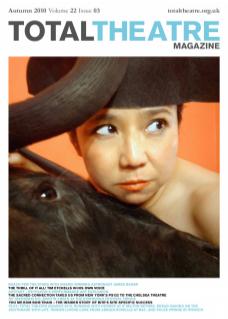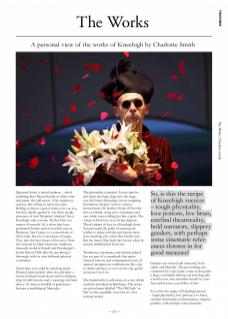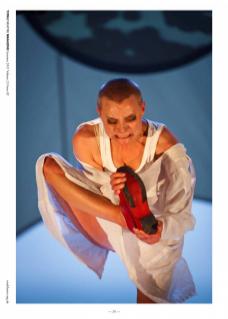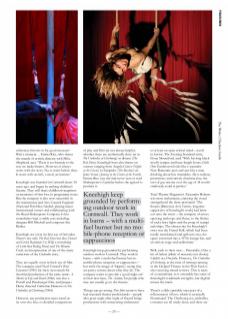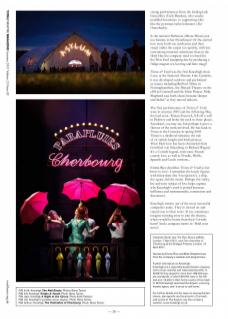Quizzical looks, a raised eyebrow… who’s watching who? Shaved heads, in white vests and pants, the odd tattoo. A bit suspicious, curious, but willing to meet your gaze. Willing to throw a pail of water over you too, but they decide against it. Are these people prisoners of war? Workers? Athletes? Toys? Kneehigh suck you into The Red Shoes in a matter of seconds. It’s a show they have performed before and revived this year at Battersea Arts Centre, so a cornerstone of their work, but also a new piece of magic. They take the bare bones of the story, from the fairytale by Hans Christian Andersen, famously retold in Powell and Pressburger’s lavish film of 1948. But the reworking is thorough, with its own hallmark physical vocabulary.
Sometimes you could be watching mime. Physical jokes include when the girl takes a shower behind closed doors and two helpers chip in with brooms and a watering can from above. Or when a handful of performers become a multilingual Mercedes.
The physicality is painful. Every time the girl slams her huge clogs into the stage, you feel bones fracturing, nerves snapping, frustration, despair. And in a sinewy denouement, the butcher chops off her feet like an animal, using just a tourniquet and saw, while sweet-talking her like a petal. The scraps of flesh live on as flying dragons. There’s plenty of love in a Kneehigh show. You just reach the point of wanting the soldier to dance with the girl almost more than anything else, when they finally start. But the dance flips back into horror when he returns shell-shocked from war.
Trombones, harmonica and clarinet played live are part of a soundtrack that spans classical bravura and contemporary beats. It spawns incongruous combinations like a jig to drum and bass, or an over-the-top, gently atrocious Can-Can.
The theatricality is self-aware, in a way which could be described as Brechtian. The actors are given boxes labelled ‘The Old Lady’ or ‘Hat’ as they squabble over roles in a live casting session.
Genders are twisted and obscured, both subtly and blatantly. The proceedings are conducted by Lady Lydia, a man in drag with a huge, extendable fishing rod and shag-pile wizard’s coat, who describes herself as ‘your host and hostess, your fisher of fun’.
So, is this the recipe of Kneehigh success – tough physicality, love potions, live brass, cerebral theatricality, bold narrators, slippery genders, with perhaps some cinematic references thrown in for good measure? Wait a moment… Emma Rice, who shares the mantle of artistic director with Mike Shepherd, says: ‘There is no formula to the way we make theatre. However, it always starts with the story. No, it starts before then. It starts with an itch, a need, an instinct.’
Kneehigh was founded in Cornwall about 30 years ago, and began by making children’s theatre. They still share childhood snapshots or memories of first love in programme notes. But the company is also now successful in the mainstream and Arts Council England (National Portfolio) funded, playing major international venues and collaborating with the Royal Shakespeare Company. It has nonetheless kept a stable core including designer Bill Mitchell and composer Stu Barker.
Kneehigh are overt in their use of fairytales. There’s not only The Red Shoes but also Hansel and Gretel; Rapunzel; Cry Wolf, a reworking of Little Red Riding Hood; and The Wooden Frock, an interpretation of one of the many variations of the Cinderella story.
They are equally overt in their use of film. The company used Noel Coward’s Brief Encounter (1945) for their own smash-hit theatrical production of the same name. A Matter of Life and Death (1946) was also a Powell and Pressburger film, and Jacques Demy directed Catherine Deneuve in The Umbrellas of Cherbourg (1964).
However, any production must stand on its own two feet, so detailed comparisons of play and film are not always helpful, whether these are aesthetically close (as in The Umbrellas of Cherbourg) or distant (The Red Shoes). Kneehigh have also drawn on sources ranging from Angela Carter (Nights at the Circus) to Euripides (The Bacchae) via Jules Verne (Journey to the Centre of the Earth). Emma Rice says she had never seen or read Shakespeare’s Cymbeline before she agreed to produce it.
Kneehigh keep grounded by performing outdoor work in Cornwall. They work in barns – with a multi-fuel burner but no mobile-phone reception or cappuccinos – but resist the image of ‘hippies’, saying they are pretty serious about what they do. The company wants to provide a ‘good night out’ at their new base, The Asylum, for people who may not usually go to the theatre.
Things can go wrong. Don John seems to have had seasoned theatre professionals – people who greet night after night of flaccid fringe productions with unwavering enthusiasm or at least an open critical mind – recoil in horror. The Evening Standard critic, Fiona Mountford, said: ‘With his long black woolly jumper and knee-length boots, Gisli Örn Gardarsson looks like a wannabe New Romantic poet and acts like a man thinking about bus timetables. He is tedious, pretentious and entirely charisma-free, the sort of guy anyone over the age of 18 would studiously avoid at parties.’
Total Theatre Magazine’s Alexander Roberts was more enthusiastic, enjoying the visual smorgasbord the show presented: ‘The theatre [Battersea Arts Centre, longtime supporters of Kneehigh’s work] had burst out onto the street – the company of actors sporting tank-tops and flares, to the flicker of tacky fairy lights and the pong of scampi and chips. The chosen site for Kneehigh’s story was the Grand Hall, which had been totally transformed and split into two, the space converted into a 1970s lounge bar, and an end-on stage and auditorium.’
Well, each to their own… Personally, I like a bit of failure (albeit of necessity not choice). I didn’t see Don John. However, The Umbrellas of Cherbourg, at the time of writing running at the Gielgud Theatre in the West End, is also receiving mixed reviews. This is more of a conundrum, as it ostensibly has some of Kneehigh’s trademark strengths, but slightly misses the mark.
There’s a slide (possibly once part of a rollercoaster) of love, which is erratically illuminated. The Cherbourg set, umbrellas, costumes are all nicely done, and there are strong performances from the leading lady Geneviève (Carly Bawden), who exudes muddled hormones, to supporting roles like the postman/sailor/animator (Aki Omoshaybi).
Is the narrator Maîtresse (Meow Meow) just too hammy in her Frenchness? Or the central love story both too saccharine and then swept under the carpet too quickly, with less convincing romantic substitutes than in the film? Has the company tried too hard for the West End (tempting fate by producing a fridge magnet set, keyring and latte mug)?
Tristan & Yseult was the first Kneehigh show I saw, at the National Theatre. Like Cymbeline, it was developed outdoors and performed at venues including Rufford Abbey in Nottinghamshire, the Minack Theatre on the cliff in Cornwall and the Eden Project. Mike Shepherd says both shows became ‘deeper and darker’ as they moved indoors.
The first performances of Tristan & Yseult were in summer 2003 and the following May, the lead actor, Tristan Sturrock, fell off a wall in Padstow and broke his neck in three places. Anecdotal, you may say, but perhaps it gives a flavour of the work involved. He was back to Tristan at the Cottesloe in spring 2005. Tristan is a medieval romance, the tale of a Cornish knight and Irish princess. Their illicit love has been chronicled from Gottfried von Strassburg to Richard Wagner. It’s a Cornish legend, with some French courtly love, as well as Nordic, Welsh, Spanish and Czech versions...
Emma Rice describes Tristan & Yseult as her ‘letter to love’. I remember the lonely figures with binoculars (the ‘lovespotters’), a ship, the agony and the music. Perhaps the tricky, hit-and-miss subject of love helps explain why Kneehigh’s work is poised between brilliance and sentimentality, connection and disconnect.
Kneehigh remain one of the most successful companies today. They’ve moved on and stayed true to their roots. If you sometimes imagine running away to join the theatre, where would be better than their Cornish barn? And a company motto is: ‘Hold your nerve’.
Charlotte Smith saw The Red Shoes at BAC, London, 7 April 2011, and The Umbrellas of Cherbourg at the Gielgud Theatre, London, 12 April 2011.
Quotes by Emma Rice and Mike Shepherd are from the company’s website and programmes.
Further information on Kneehigh:
Kneehigh are a regionally-based theatre company with a local, national and international profile. In 2009/10 they played to more than 189,000 people worldwide, of which 89,000 were in the UK and over 13,000 in their home county of Cornwall. In 2010 Kneehigh launched the Asylum, a touring theatre space, and ‘a venue to call home’.
For further details and for news on touring theatre shows, site-specific and local work in Cornwall, and events at The Asylum, see the company website: www.kneehigh.co.uk
